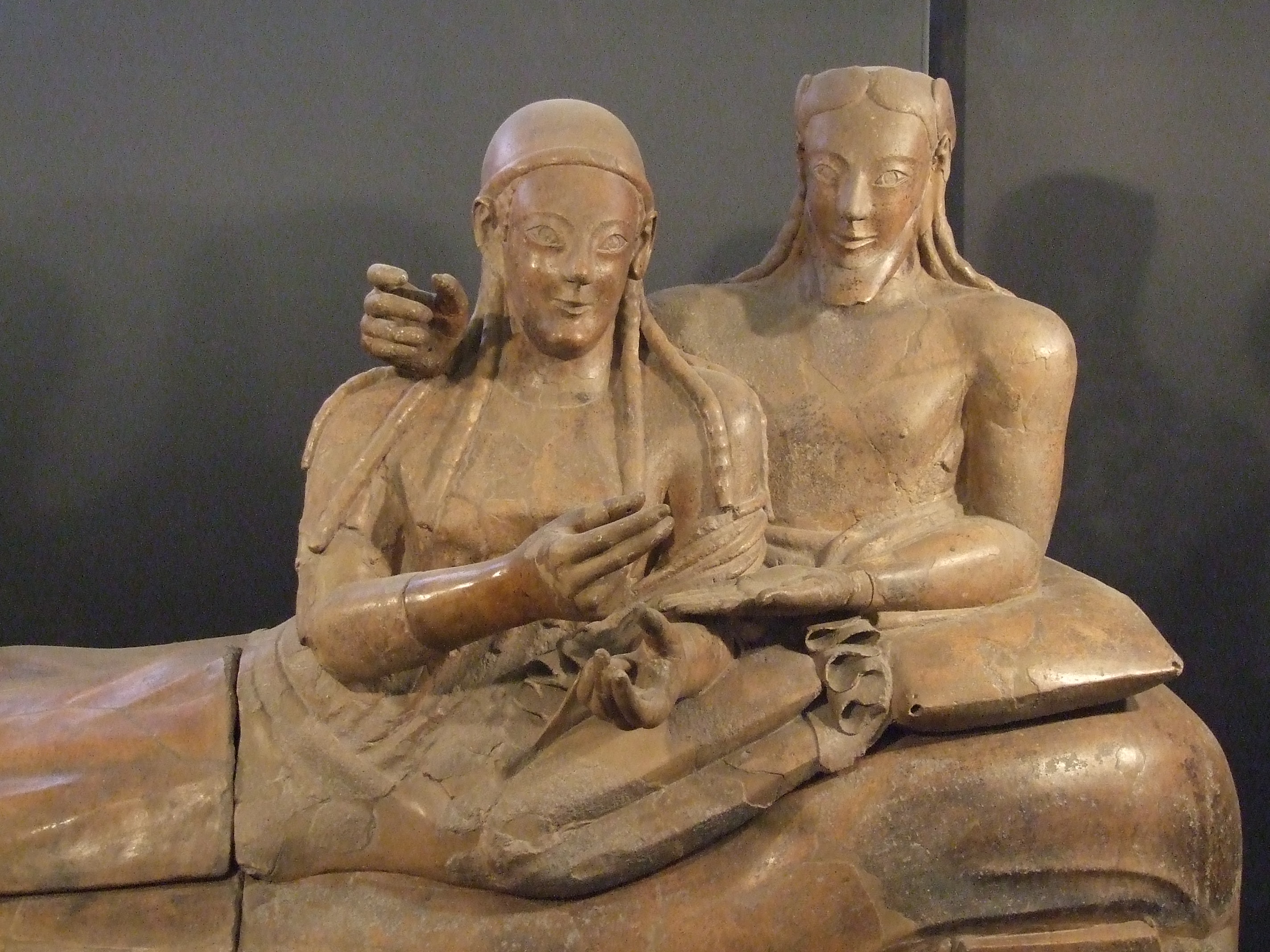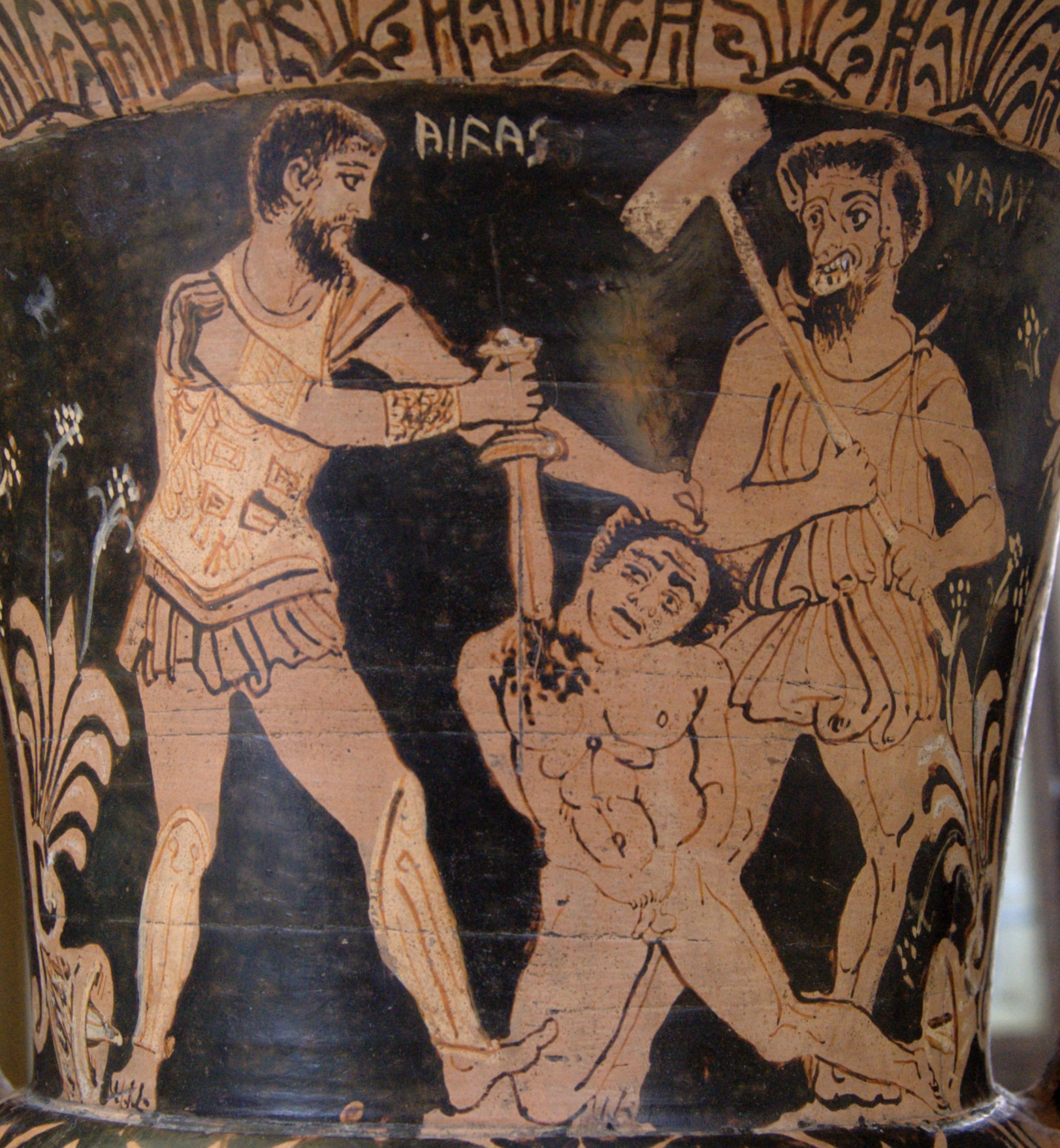Charun and Vanth From the Tomb of the Anina Family
On the walls of a 300 BCE Etruscan tomb, a winged woman of dark and stern gaze flanks a door to the unknown. Her name is Vanth, and she often makes an appearance in violent scenes where one or more than of the individuals depicted is on the verge of death. Is she the angel of Death, or perhaps Death'due south messenger? If we take a closer wait at the objects that she carries –a bunch of keys and a burning torch — we'll realise that her role is that of a psychopomp, a liminal entity who guides the newly deceased into the Great Unknown: the Otherworld.
What we know most the Etruscans is largely based on tomb inscriptions and funerary fine art, since very few of their written records remain. This has just intensified their aura of mystery, a project of the conspicuous Etruscan smiling, secret and enigmatic, frozen on the lips of the funerary statues of those who take crossed the threshold and therefore know secrets beyond our reach.

Like the Greeks, the Etruscans believed in the existence of a Realm of the Dead, but the journeying towards information technology wasn't necessarily smooth. Information technology would begin with the burial rites performed by the family: funerary urns depict a procession, like to the Roman pompa funebris, merely in this example there are demons mingling with the living. We don't know whether they tin be seen or sensed by mere mortals, only together they take the remains of the recently deceased to the door that separates this world from the Otherworld. It is at this bespeak that the living must stay backside.
Representations of this door ordinarily appear on the far wall of Etruscan tombs, always guarded by demons, part male or female, function monster or beast. Vanth, the winged demoness, is probably the nearly recurrent gatekeeper. Her keys open the gate, her torch lights the night paths of the Underworld. The serpents effectually her arms reveal her liminal nature: snakes, always in contact with the earth, are frequent companions to chthonic entities.

Vanth is usually depicted with hunting boots, a short pleated skirt, and straps beyond her bare breasts – the attire of a Greek huntress. This is 1 of the reasons why she'southward been suggested to take a Greek origin, perhaps inspired by the Erinyes, infernal goddesses of vengeance, too winged, simply far more fearsome.
She is often accompanied by a less chivalrous-looking hybrid effigy, one with animal ears, pointed teeth, and snakes twined around his arms. Funerary inscriptions reveal his proper name is Charun – probably an adaptation of Charon, the Greek ferryman who begrudgingly escorts souls to Hades. Showing the decay of expiry in his bluish complexion, the Etruscan Charun is armed with a hammer, which he sometimes swings over a person's head in a threatening manner. His brutish impulse may betoken that he isn't simply a psychopomp, simply also a protector of the dead, in accuse of fending off evil spirits from the tomb.

Intriguingly, the doors guarded by Vanth and Charun may sometimes be one-half open up, so we tin can catch a glimpse of the other realm. Some depictions, such equally the sarcophagus of Hasti Afunei, are rather ambiguous, just it would seem as if the expressionless have come to open the door from the inside. These figures aren't malevolent, they're likely family members whose function is to greet newcomers and reassure them as they are about to enter the Bully Unknown.
The most dangerous part of the journey would indeed start on the other side. Since Vanth appears escorting the dead in different means (on horseback, wagon or chariot) it is reasonable to retrieve that the transit probably had unlike stages. Depictions of sea monsters suggest that at some bespeak or other the deceased would take to face a body of water voyage. The rocky coastline painted on the walls of the Tomb of the Blue Demons (c. 400 BCE), where a legion of demons awaits past a skiff, seems to reinforce this idea.
Vanth and Charun might have been used as commonage names for death demons in later Etruscan periods. We know the names of other creatures who bear witness like characteristics: the bearded Tuchulcha, whose gender is debated by scholars, has wings and a nib, and wields a mallet; the enigmatic Culsu carries a scissors, perhaps to astringent the soul from the body.
Whereas some of these entities could exist more than malevolent, at that place seems to be a full general consensus in the protective roles of Vanth and Charun. The Etruscan Underworld was plagued by monsters (some of them equally familiar as Cerberus, the iii-headed dog who guards the archway to Hades; Geryon, the behemothic warrior; or the Gorgons, whose gaze could turn a human into stone). All these perils, and those that we don't know, given the scarcity of written sources, suggest that the presence of the stern Vanth and the brutal Charun were essential for the survival of the soul.
Sources:
Nancy Thomson de Grummond, 2006. Etruscan Myth, Sacred History, and Legend. University of Pennsylvania Printing.
Sinclair Bell and Helen Nagy (ed.), 2009. New Perspectives on Etruria and Early Rome. Academy of Wisconsin Press.
Sinclair Bong and Alexandra A. Carpino (ed.), 2016. A Companion to the Etruscans. Wiley Blackwell.
Source: https://folklorethursday.com/myths/winged-demoness-death-vanth-etruscan-underworld/
0 Response to "Charun and Vanth From the Tomb of the Anina Family"
Post a Comment